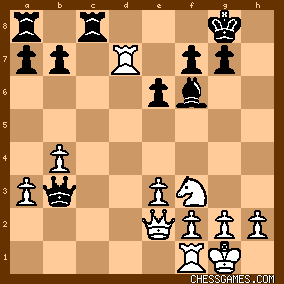| Bridgeburner: This qualifies as a perfect game as neither side made a mistake. The outcome was more or less determined by Capablanca’s <15.Rfc8>: The king rook was brought to that square to save the tempo consumed deploying the queen rook to <c8>(<a6> had to be played before the QR could be moved). BUT… the removal of the king rook from <f8> leaves one less defender around the Black king AND there is no way Black could avoid the discovered attack that <16.Rad1> created on the d-file BUT the drawback of this move is that it left the queen side pawns unprotected. <16.Rfd1> doesn’t work as well as after <17.Bxf6 Bxf6> Black’s DSB is attacking White’s rook at <a1>. So of course White attacks the king side and Black snips at the queen side. The next decision point had to be in respect of White’s 20th move. Position after <19…Kg8>: 
click for larger view<20.Rxb7 Qxa3 21.Qb5 a5! 22.Qd7 Rf8 23.bxa5 Rxa5> is a very drawish heavy piece ending as White’s extra pawn is going to be impossible to cash in when all the pawns are well defended and on the same side of the board. If <20.Nd2 Qxa3 21.Qh5 Rf8 22.Ne4 Qb2>: Now if <23.b5> then <23…a5!> creates that passed a-pawn again. If <23.Rxb7 Rab8!> and all the queen side pawns end up dissolved, with the same drawish heavy piece endgame appearing with all pawns on the king side. If <23.Rfd1>, the <23…b6> followed by <24…a5>, and there’s that pesky passed a-pawn again. The move chosen by Rubinstein, <20.h4>, builds a poetic fluidity, a smooth choreography, into the outcome as the rest of the moves virtually choose themselves to provide an aesthetic finale. This would have been a pleasing game for Rubinstein in what was a wretched tournament for him. | 




